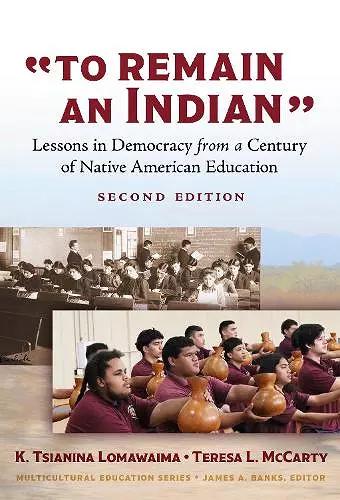"To Remain an Indian"
Lessons in Democracy from a Century of Native American Education
Teresa L McCarty author K Tsianina Lomawaima author James A Banks editor
Format:Hardback
Publisher:Teachers' College Press
Published:24th Dec '24
Should be back in stock very soon
This hardback is available in another edition too:
- Paperback£40.00(9780807786123)

“Offers a balm against despair (and) provides an inspiring theoretical frame for those who continue to fight for indigenous control.” —Tribal College Journal (of first edition)
"This second edition is essential reading for reckoning with the ongoing attempts to diminish Indigenous nations’ languages and cultures through schooling.” —Noelani Goodyear-Kaʻōpua, University of Hawaiʻi at Mānoa
“To Remain an Indian” traces the footprints of Indigenous education in what is now the United States.
Native Peoples’ educational systems are rooted in ways of knowing and being that have endured for millennia, despite the imposition of colonial schooling. In this second edition, the authors amplify their theoretical framework of settler colonial safety zones by adding Indigenous sovereignty zones. Safety zones are designed to break Indigenous relationships and impose relations of domination while sovereignty zones foster Indigenous growth, nurture relationships, and support life.
This fascinating portrait of Native American education highlights the genealogy of relationships across Peoples, places, and education initiatives in the 20th and 21st centuries. New scholarship re-evaluates early 20th-century “reforms” as less an endorsement of Indigenous self-determination and more a continuation of federal control. The text includes personal narratives from program architects and examines Indigenous language, culture, and education resurgence movements that reckon with the coloniality of U.S. schooling.
Book Features:
- Enriched theoretical framework contrasting settler colonial safety zones designed to control with Indigenous sovereignty zones designed to nurture Indigenous futures.
- The voices of activists and educators who are linked together in a genealogy of Indigenous educational self-determination.
- Developments in Indigenous schooling contextualized within the Piper v. Big Pine and Brown v. Board desegregation cases.
- Empirically updated case studies of ongoing language, culture, and education resurgence movements.
- Recent scholarship highlighting Progressive Era continuities in federal powers over Native Peoples and the impact of the 1924 Indian Citizenship Act.
- Visual imagery, including historic and contemporary photos of people and programs, curricular materials, and schools. <
“Offers a balm against despair (and) provides an inspiring theoretical frame for those who continue to fight for indigenous control.”
—Tribal College Journal (of first edition)
ISBN: 9780807786130
Dimensions: 235mm x 162mm x 18mm
Weight: unknown
288 pages
2nd edition